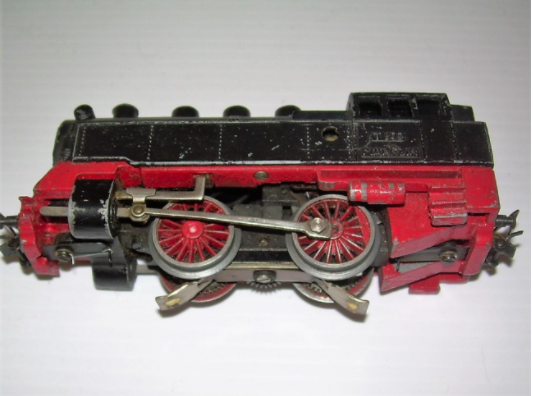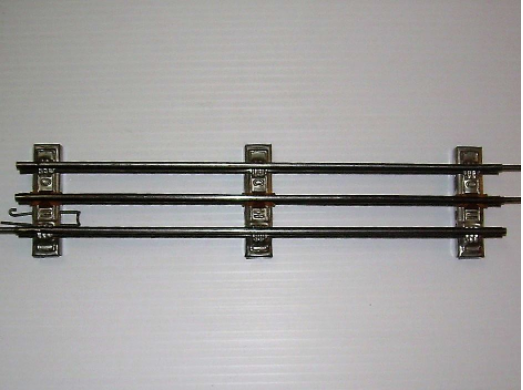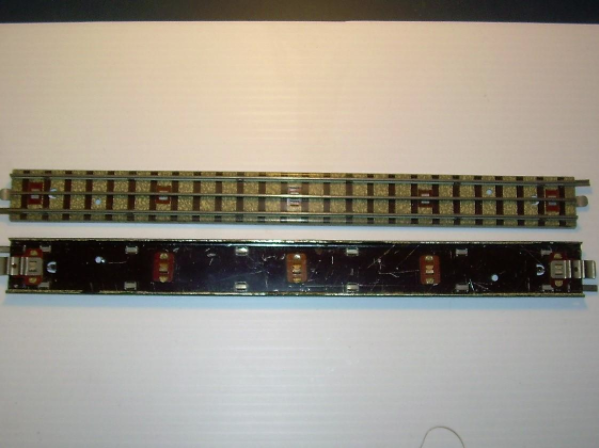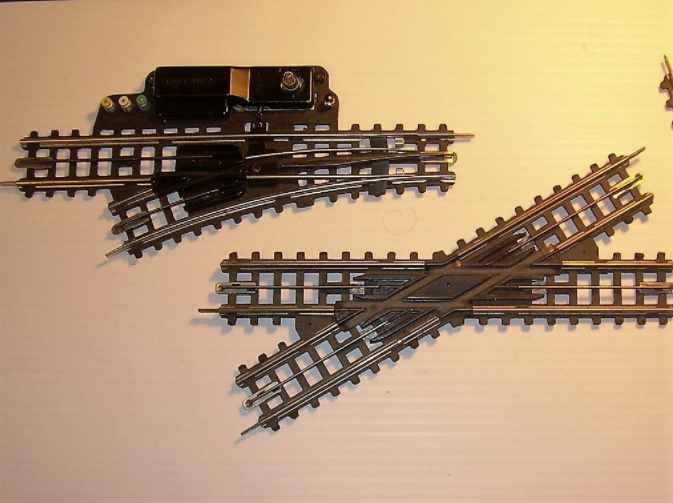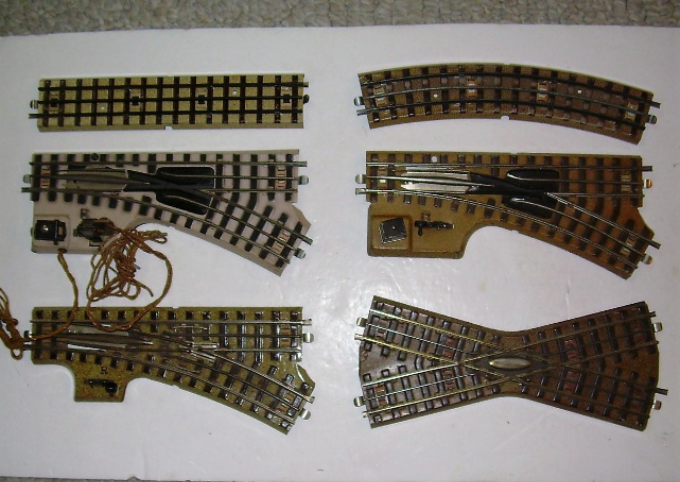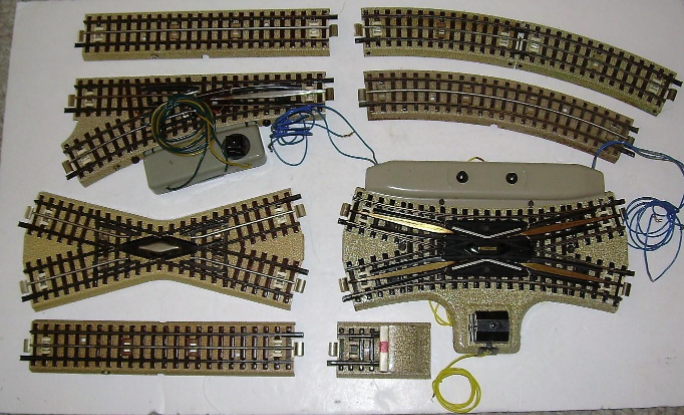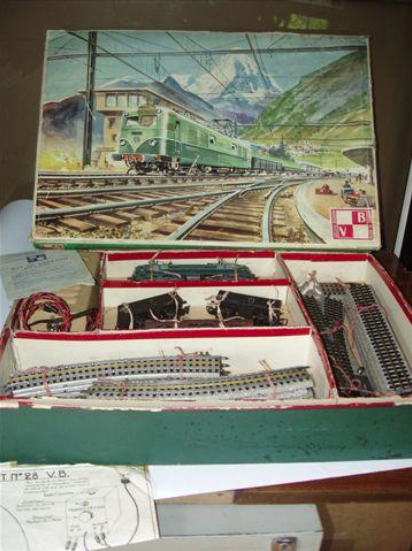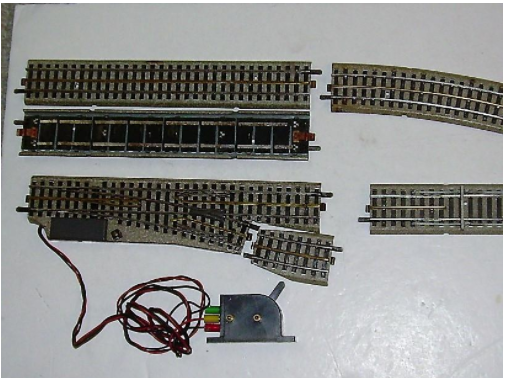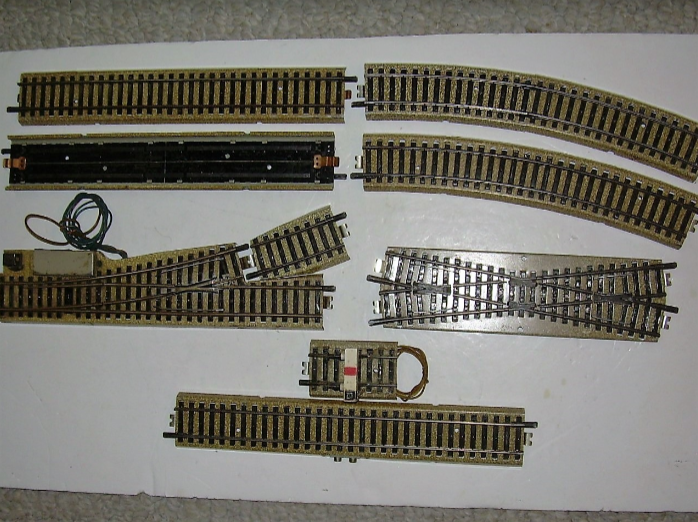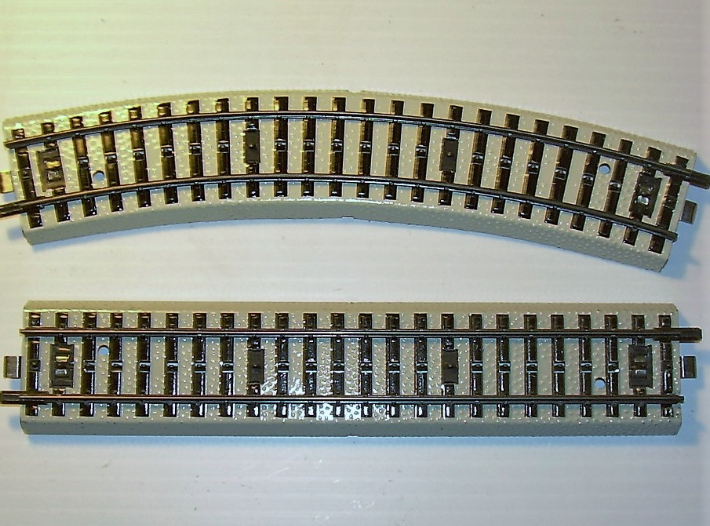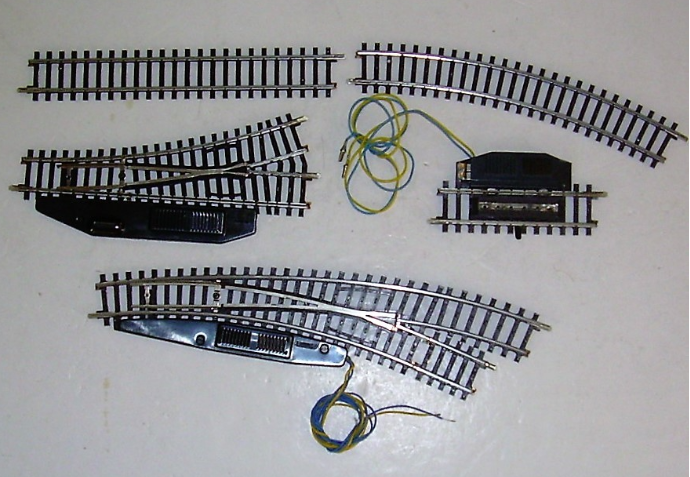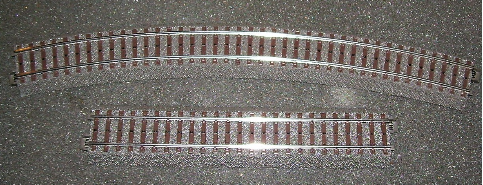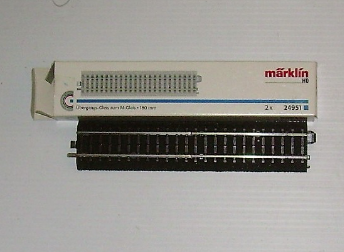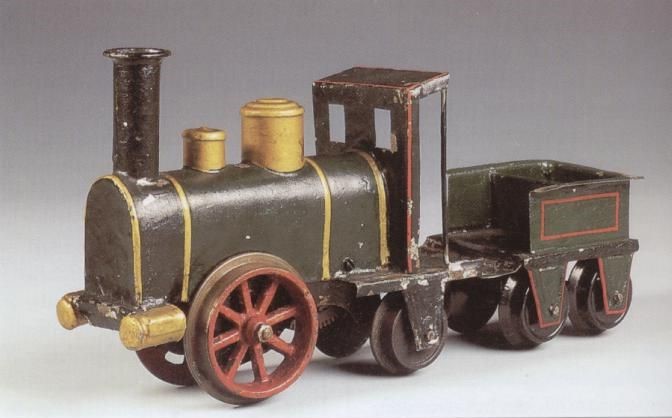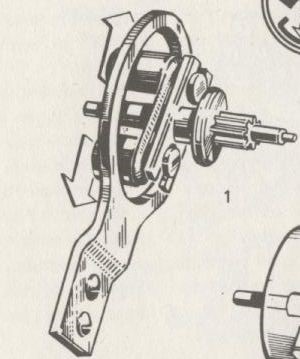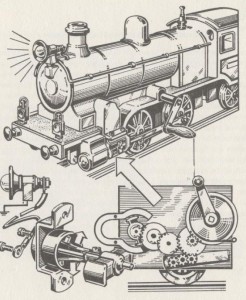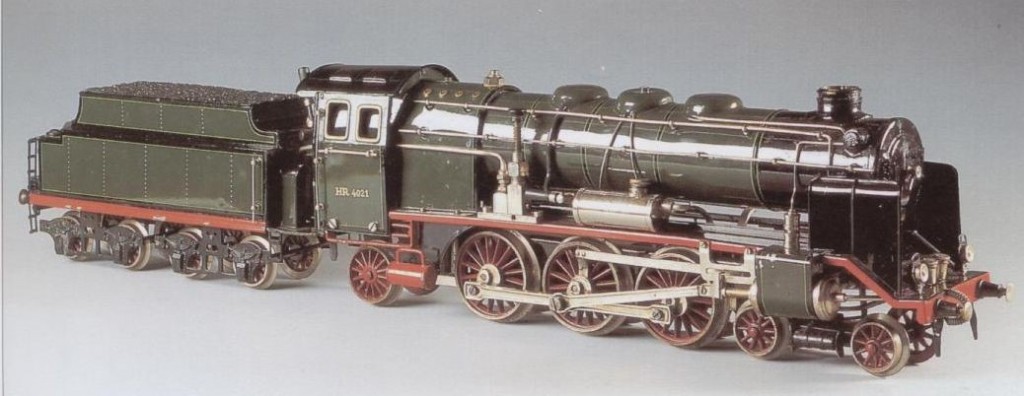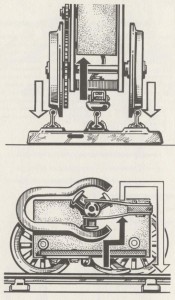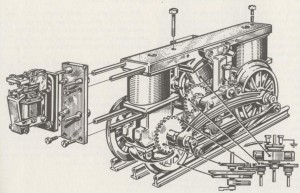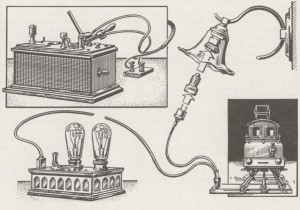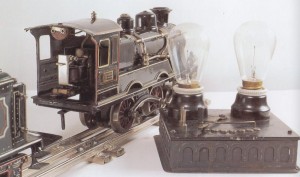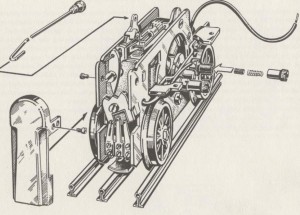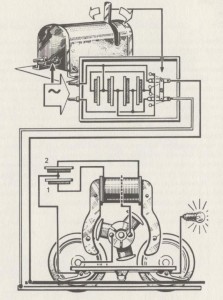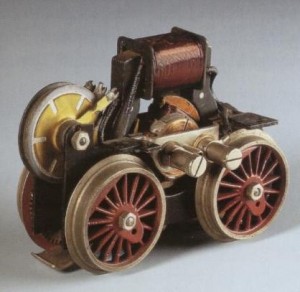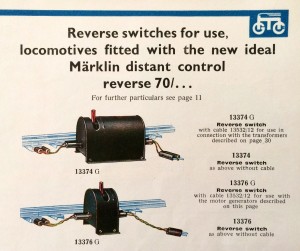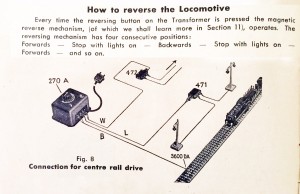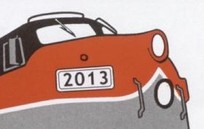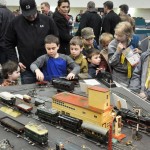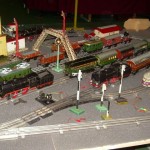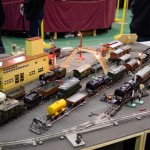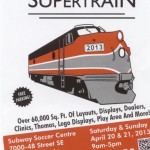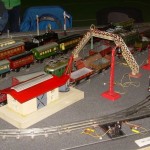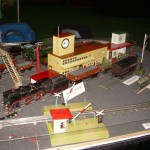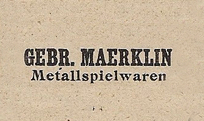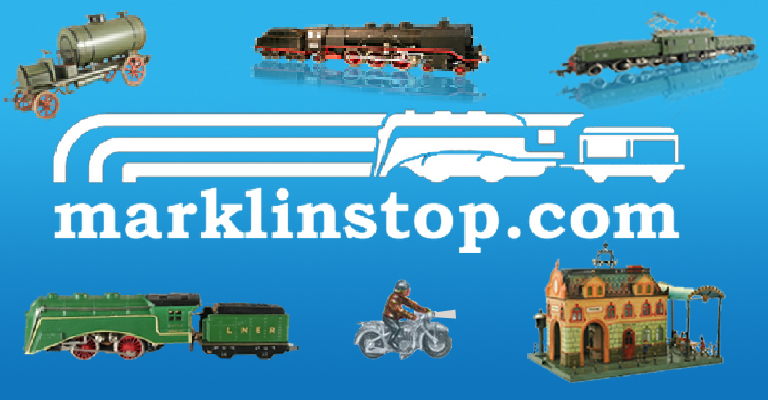THE BEGINNING, 1859
The founder of Märklin (also “Marklin” and “Maerklin” more commonly in the US) was Theodor Friedrich Wilhelm Märklin (1817-1866), a master tinsmith. He moved to the small southern German town of Göppingen with his second wife Caroline (his first wife had died) in 1856, where he purchased the “Resident-rights” from the city and was henceforth registered officially as a “tin-smith”. With Caroline he had 3 sons: Wilhem Friedrich, Carl Eugen and Carl Adolf.
Caroline Märklin: the traveling salesman
The firm “Wilhelm Märklin” was established in 1859. The main products consisted of dolls, kitchens, and similar accessories for girls. The firm was very successful and moved into a larger house. This house had a trapdoor into the cellar where the toys were produced. One evening an apprentice had not closed the trapdoor. Wilhelm did not see this and fell into the cellar and sustained broken ribs and other injuries. He died within a few days on December 20, 1866.
This was a very difficult time for Caroline: she had 3 young sons (the youngest merely 6 months old) and a young daughter from a previous marriage. She undertook the difficult task as salesperson to promote and sell their articles to toy-shops everywhere in the country. She died in 1893, and the helm of the firm was taken over by her son Eugen and his brother Carl under the name of “Gebrüder Märkin” (Wilhelm Friedrich had moved to Alaska. He never saw his family again and died there in an old folks home).
Laying down the tracks
In 1891 Eugen bought the firm Ludwig Lutz, a firm which at that time produced the finest metal toys, including the first trains. The first O Gauge Märklin locomotive was produced in 1893 with a strong clockwork mechanism that when wound up several times, would send a single locomotive flying around the track enough times to make your head spin. These O Gauge trains and subsequent standard gauges (O, I through V) were standardized by Märklin at the Leipzig Easter Fair where new innovations and produces were commonly first introduced.
GOLDEN AGE OF MÄRKLIN TOYS
In the early part of the 20th century Märklin built metal toys, including miniature stoves that actually worked, steam ships with clockwork or real steam power, steam engines, toy guns (Germany was of course geared towards war for many years), clockwork cars that could be disassembled to be fitted with other types of car bodies, electric slot-car systems, metal tops, and other non-train related metal toys, including die-cast cars, not unlike Dinky. Märklin produced toys of every kind, some playful and others built for realism: from shooting games with clown characters to realistic fountains and fire trucks that pumped water through tiny rubber hoses. During the years 1909 to 1914, Märklin produced a two-gate cattle rampe Nr. 2552/0 in Gauge-O that featured a cattle shepherd, two working gates, and even a little ramp to load the sheep! During this first period of rapid expansion, Märklin solidified itself in the toy industry and built its name in international markets as a produce of fine metal toys. When looking across the entire span of Märklin production from its founding to today, Märklin during this period offered some of the most diverse and interesting products that were unfortunately discontinued in later decades.
Such masterpieces took workers in the factories hours to meticulously build. Tin toys which represented a majority of the Märklin produce line during this period would begin as large sheets of tinplate which would be cut down to size using large presses and cutting dies. The next step would be to form these smaller cut sheets into desired shapes with some contour to them. This process was either done with a rubber hammer in hand or with a large die press. Tinplate sheets sandwiched between two large engraved plates would cut out window holes or doorways with force coming from both plates. After tin sheets were cut and formed to shape they would be soldered together by experience tinsmiths. Finally the painting phase would begin which perhaps required the most skill and attention to detail. An array of brilliant enamels would be applied to the tinplate and baked in an oven between coats to ensure the durability of the paint. Finally gold lining and finely detailed embellishments (such as painted rivets, destination signs, and flags) would be applied all by hand. Stamps and brass engraved name plates would be applied and the final produce sealed with a coat of varnish to ensure a brilliant finish that would last for decades (even centuries) to come. Surely pieces still existing today in excellent condition which were produced in this period are a testament to the skill of Märklin craftsmen.
FACTORY IN GÖPPINGEN
The firm was growing! Eugen Märklin had 9 children, amongst whom Fritz, who later took over the business, Richard, who headed the firm’s branch in the US and Willy, who even later took over the firm. Claudius Märklin, son of Willy, later became editor of the Märklin Magazin. The firm expanded to its current location on Stuttgarter Strasse in Goppingen in approximately 1907 and had around 700 employees according to a newspaper article. The factory and Märklin’s business remained relatively in tact during both World Wars despite considerable losses of employees to the war effort and a temporary shift in production to war materials. During World War 1, Märklin produced shell casings, belt buckles, and various other manufactured items which could be made relatively easily with the already present metal stamping equipment. The Second World War forced the Märklin factory to stop production in approximately 1945 to yet again produce items for the war effort including pressure sensitive detonators and small engines for torpedo propulsion. More can be read about Märklin during WWII in the episode EP #11 – Märklin during World War II.
Other people that were important in the history of the firm include Richard Saft, whose command ot other languages helped in the export to foreign countries, and in post WW2 years Helmut Kilian and Otto Bang Kaupp who furter developed the H0 line.
After the death of Fritz Märklin in 1961 the Märklin family was no longer represented in the firm after a period of 102 years.
Export markets around the world
Of course Märklin toys circulated around the world during the very early years of production as Märklin was always known for its incredible quality, but the Golden Age period of Märklin brought many international importers of Märklin products. Märklin responded not only by supplying its toys to these importers in bulk but also by manufacturing toys and trains for specific markets. Toy enthusiasts of Great Britain enjoyed beautifully colored trains of the L.M.S, L.N.E.R, and G.N.W.R. railways and stations and platforms (many feet in length!) of all gauges delivered through distributors Gamages and W. Seeling of London. The American market was sustained by the flagship toy stores and distributers F.A.O. Schwarz in New York, Richard Maerklin Toys (see more EP #8 – Richard Maerklin Toys: A US Maerklin Legend), and Charles C. Merzbach in the late 40s and 50s. Toys for the American market not only had English lettering for signs and inscriptions but also featured cowcatchers instead of front buffers, bells, tunnel lights, and sometimes special paint schemes as was produced for Richard Maerklin Toys: a swiss crocodile CCS 66 12920 locomotive painted snow-white for the NEW YORK CENTRAL LINES and a French mountain locomotive ME 66 12920 painted apple-green. Political relations around the World War II era stunted the export production for Märklin which meant many planned models were never produced. However, the first customer catalog after the War featured in 1947 a series of 00 Scale wagons and locomotives produced specifically for the U.S. market including the ST 800 and DL 800 streamlined diesel-locomotives.
THE FAMOUS MÄRKLIN TRAINS AND THEIR GAUGES
In their assorment of trains, Märklin standardized several gauges. The first trains were “floor runners”. The first “system-railroad” was developed as early as 1891 by Märklin, and the firm was instrumental in developing a standard for trains and tracks, accepted by other toy train makers, a novelty in the toy-train world. Their Gauge 1 had its culmination in the famous “crocodil”, first built in 1933. This electric loc became soon the “flag-ship” of the firm, produced in the pre-war gauge 1 and 0, and in the post war gauges 00/H0, Z and 1.
Gauge 0 started in 1896, and in the thirties this gauge became more popular than their gauge 1, which was abandoned in the mids thirties. All these trains, altough very realistic looking, were of course TOYS: the doors of the cars could be opened, signals and switches were often manually operated, and so on. Play-value was very important.
Märklin experimented with a smaller gauge than 0 in the late 20s, which they called 00 “Liliput-Bahn”, scale 1:70, (roughly equivalent to S-gauge) with one wind-up steamloc, later augmented with an electric 4V steamloc.
This experiment never came off the ground in significant numbers however. Even in the 30s a very detailed prototype steamloc was built for this scale but was never produced.
It was not until 1935 that Märklin came out with their first mass produced 00 scale, later in approximately 1947, the scale was dubbed H0 (or half-0). Trix, a competitor, was equally engaged in the early production of 00, and Marklin had to rush to present a display layout at the 1935 Leipzing spring toy fair to meet the competition. Märklin came out with a slew of 00 wagons and two electric locomotives: a steam 0-4-0 R 700 and an electric RS 700 of the same wheel arrangement (pictured right: top-to-bottom 1935 versions of RS 700 E-Lok, R 700 Steam, and 3600 AR regular track). Märklin always maintained its historically grown three-rail AC operation, which is more reliable and electrically less complicated than two-rail DC. An exception to this was the “Hamo” line, which ran on 2rail DC. Marklin purchased the Hamo company that made H0 streetcars in the 1964 and equipped some of the Märklin train models with DC 2-rail motors. The production of 0 gauge trains was phased out after WW2 and stopped completely in 1956.
The decrease of large-gauge production had several reasons:
- After the war many people had moved into smaller houses where there was little place for an extensive 0-gauge layout.
- People had more leasure time available for hobbies. H0 trains had become mass produced, and with the introduction of plastic, products had become more readily available to lower income people.
- A smaller scale allowed for enthusiasts to build extensive layouts complete with buildings, track, small figures, and realistic trains in a relatively small space.
- One must not forget that most Märklin products such as trains, steam engines, boats etc. were very expensive at the time and were mostly available only to the children of affluent families.
In 1969 Märklin introduced the new gauge 1 system with DC current.
In 1970 Marklin re- introduced an 0 gauge train that ran on H0 track: an 0H0 train for children, the “Minex”.
In 1972 the firm surprized the world with the production of the smallest system model railroad: The Z gauge.
| Gauge |
Track Width |
| 00 (1928) |
16.5 mm |
| 00 Liliput (1912) |
26.5 mm |
| O |
35mm |
| I |
48mm |
| II |
54mm |
| III |
75mm |
MOTIVE POWER
When Märklin introduced movement and motion to their toys, the excitement reached a whole new level of play-time entertainment. Toy trains in the late 1800s which moved by pulling a string attached to the front buffer were propelled down the tracks in the 1893 by clockwork motors and a little later by electric and steam ones. Today digital technologies allows precise control over toy locomotives and accessories that mimics the complexity and possibilities of a live railroad operation.
Clockwork
The development of a strong and compact clockwork motor which could be fitted inside a locomotive engine was a huge advancement in motive power. At first the motor was a bit primitive: when wound, the engine would shoot forward as the internal spring unwound, possibly derailing on the curves because of the high speeds. Although Märklin’s clockwork springs were known to be very efficient and could propel a train around a loop many times, a lot of winding was necessary and a train would be out of power in no time.
Electric
A novelty was that Märklin offered electric trains as early as 1895. In those days few cities in Europe had electric power available, but it was present in the halls of Göppingen! Electric power for the locs was either through high voltage (220V, reduced to 50V by means of lightbulbs) or 4V DC (battery). Eventually the 50V system (“Starkstrom”) was prohibited by the government. At that time the low voltage transformer had become feasible and the less dangerous 20V systen became the main power for 0 and even 00, from 1926 on. Advertisements of the 20s and 30s lauded the safety and ease-of-use of electric current for toy operation which undoubtedly was much more safe than live steam or gas-powered operation! And of course the digital age took control of the power in the Märklin H0 trains as early as 1980 and used the pathways of electricity to control the digital functions of the trains and railways operations.
Live steam
Another form of power was of course live steam: this was available in the Gauge 1 and 0 steam engines. Live steam engines could be found in many Märklin products including locomotives, ships, stationary steam plants (which generated electricity to power lamps and accessories), and rolling tractors. Almost all products running off live steam were powered by an alcohol burner which heated a boiler tank filled with water. These toys were vary dangerous for small children because of the open flame to burn the boiling hot water. Such live steam products were often sold in sturdy wooden crates and were packed with various tools to assist with maintenance of the engine: a small bucket to fill the water reserve, a funnel to pour the water and alcohol, and various wrenches to adjust the pressure valves.
Air and Lift
Worth mentioning here is the compressed air that Märklin used in the 20s to operate signals and switches by means of thin rubber hoses.
MÄRKLIN AND TOYS
Toys for children, which had been Marklin’s main product from the inception of the firm, had by this time almost completely disappeared from their line. Children no longer played with the more sophisticated and delicate scale models: these were now sold to serious adult model railroaders. The era of toy trains for children to play with was over. Marklin recognised this waning market and made several attempts after the mid-fifties to rekindle the interest of children in trains and other toys, well expressed in many of their catalogues.
In 1953 Marklin introduced a clockwork H0 train, with a plastic streamlined 0-4-0 locomotive, the S870 (loosely built after a Pennsylvania RR streamliner), which came as a set with 2 passenger cars #327/2 in maroon-red, or as a freight set with a silver or red coloured dump-car and a #4503 gondola. The train could run on the common M-track. This track was offered for the clockwork train without the central power stud system, which could later be installed. The train did not sell well: it found only a limited market. The plastic locomotive (with plastic wheels!) broke quickly under the rough hands of childs play. By 1957 it had disappeared from the catalogue. H0 clockwork
In 1970 Marklin tried again to get children interested in H0 trains by producing an 0H0 train: “Marklin Minex”: this was an electric 0 scale train system which ran on the common H0 M-track. The engines ran on 16V AC and had the same reversing mechanism as the H0 engines. Two sets were offered: a set with a lighted 0-6-0 tank locomotive with 2 passenger cars, and a freight diesel engine set with a gondola and a dump car. A separate hand-operated semaphore signal with train control was also available. The engines and cars were very attractive. They were made of plastic and metal and were equipped with the regular Marklin H0 couplers. These large trains were easy to handle for children, but again they disappeared from the Marklin offerings after a few years in 1972. Minex
Märklin also re-introduced a slotcar set in the early 70’s” Märklin Sprint”, and plastic building blocks not unlike Lego, the “Märklin Plus”.
Alpha
Marklin once more tried to capture the childrens market in the late 80s. This time the firm invited children to design their own “dream-train”, which resulted in the production of Marklin’s “Alpha adventure sets” in 1988. High-speed locomotives (an 0-6-0 with tender) and cars had a futuristic look, were equipped with the regular Marklin H0 couplers and ran on a new “three-rail” plastic-based track system, called the “2000 track”. The boxes in which the sets were sold could also be used to act as tunnels, mountains and other scenery. Cars could store futuristlic looking automobiles and trucks. These trains were indeed built for “high play” value. The system could be powered by rechargeable power units (which unfortunately did not function very well). The Alpha adventure sets were last seen in the 1995 catalogue. They were too expensive and did not sell as hoped for. However, the good news resulting from the Alpha sets was that Marklin developed the plastic base track system further into the “C-track”!
Sprint, Lego
In recent years The Marklin production line offers trains only. Three scales of trains are being produced: H0, 1 and Z. All other toys, once depicted in the early post war catalogues such as ,the Marklin construction sets (“Märklin Metall”), electric experiment sets (“Marklin Elex”), die cast cars, slot cars (“Marklin Sprint”) and even a Lego-like building blocks system (“Marklin Plus”) are no longer being offered. Once in a while Marklin produces nostalgic expensive replicas of their famous older toys, such as metal construction car and airplanes, a metal steam ship, a steam engine, a dolls pram and a carouyssel. These “toys” are meant for collectors only. The basic underlying message is that Marklin is no longer a maker of toys. Whether this is due to a changing world or to the vast array of different other, cheap mass produced toys available everywhere, is a matter of opinion.
MÄRKLIN ANNO 2012
The firm had some of its glory-days in the mid to late 30s. During WW2 production of trains etc. had stopped and Märklin was involved in the war machine with the production of mine-detonators and a few other mechanical devices. The factory was spared from a bomb-attack on the nearby railway in 1944. By the way, Hermann Goering was an avid Märklin enthusiast. He had an enormous 0 gauge Layout built in his estate, CarinHalle. The building was destroyed at the end of the war. No records remain of the collection other than in a few pictures. In the post war years the firm established itself once again as maker of high quality model trains and went through a period of growth and success (in 1959 the company had 2000 employees).
Märklin trains were considerd the “cadillac”in the model train world for eye to detail, reliablility and quality. Financial troubles started around the turn of the 21st century and around 2010 Märklin had to file for bankruptsy protection. It went through a series of staff reductions and the firm seems to have established itself once again, with this difference that numerous components and possibly complete trains are now……..”made in China” (like the famous German Leitz microscopes!).
CONCLUSIONS
With just over 150 years in existence, the firm Märklin has earned a reputation for top quality toys and model trains. The genuine toys have by now disappeared from their line of products. Arguably the firm is no longer a leader in fine model railroads, but is still an active producer. They have taken over Trix and even more recently LGB.
Märklin trains are being avidly collected: Old gauge 1 trains and larger gauges have become very expensive and rare. Gauge 0 is also becoming expensive and even the 00/H0 trains from the 40s and 50s have soared in value. For years, auction houses like Sotheby’s and Christies refused to handle these old trains: they were not “antique”. In more recent years however these auctioneers have a steady stream of valuable Märklin (and other) toy trains in their “toy-auctions”. The trains were always expensive new, and even now the old trains are very expensive.
REFERENCES
Several books have been published (mostly by German authors) on antique toy trains, and more specifically on Märkln. These books offer a wealth of information.

